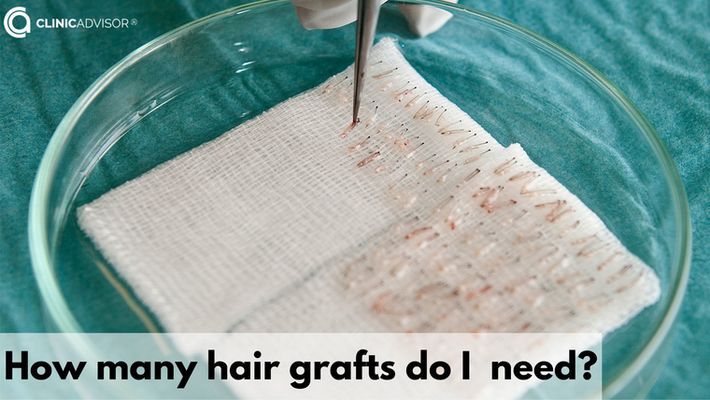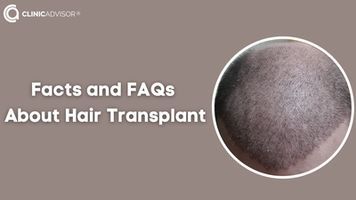Medically reviewed & verified by: Prof. Dr. Naci Karacaoglan
Written by: ClinicAdvisor®
The first thing patients ask before getting a hair transplant is, "How many hair grafts do I need?".
To answer this question, we need to consider many factors.
The two most important factors are the hair loss degree and the availability of hair in the donor area.
So, let's discuss more hair loss degrees and how many grafts will be needed for your hair transplant.
How can the hair loss degree be determined?
Many doctors use the Hamilton-Norwood Scale for hair loss to know your hair loss stage and the number of grafts needed to cover the balding areas.
The Norwood Scale classifies the different stages of hair loss for those suffering from male pattern baldness.
It helps determine the proper hair loss treatment and whether a topical or surgical intervention will be needed.
What is a hair graft?
A hair graft is a tunnel-shaped structure in the skin's epidermis (outer layer) that contains hair follicles.
This structure - called a hair graft or follicle - is removed from one area of the body to be transplanted into another area. This is what a hair transplant is.
Hair grafts can contain 1 and 4 hairs. Hair grafting is commonly used within hair transplants to treat baldness or to restore hair growth after an injury.

The healthy follicles are usually taken from the back of the head, as this is an area where the hair is typically resistant to balding.
The surgeon will make small incisions in the recipient area during the procedure and insert the hair grafts into these incisions.
The grafts will then take root and begin to grow new hair. In some cases, multiple sessions may be required to achieve desired results.
However, hair grafting can offer a permanent solution to hair loss and can help to restore a natural-looking hairline.
You can read more about what is a hair graft in this article.
How many hair grafts do I need for my hair transplant?
The level of baldness on the Norwood scale varies from one patient to another. This naturally leads to the different needs of each patient in terms of the number of follicles and the number of operations that might be needed.
The goals and desires of patients in terms of density differ from one person to another. This, in turn, affects the number of grafts necessary.
While for some patients, 100-1000 grafts can be enough; there are those whose cases need more than 12,000 grafts, which is usually done in 2-3 sessions separated by at least six months.
Therefore, obtaining a special consultation from a hair transplant specialist is essential to determine the approximate number of follicles needed.
To get an initial idea of the number of hair grafts you need for a hair transplant, you can look at the illustrations below for each hair loss stage with the suggested treatment and the number of grafts required:
At this stage, there is no visible hair loss, but we notice a slight receding of the hairline in the frontal area, which is not clear. How many grafts are needed? Hair transplantation is not necessary at this stage. Other non-surgical treatments can be used. What are the treatment options? Patients can use topical treatments or get Regenera, Mesotherapy, or PRP sessions to control hair loss and stimulate growth. |
In the second stage, hair loss becomes more noticeable on the hairline, which begins to recede slightly, especially in the temporal region. How many grafts are needed? At this point, a hair transplant can be an option to restore the receding hairline and temples. It is possible to transplant between 1000-1500 grafts to restore the hair. What are the treatment options? Topical treatments such as Minoxidil can be used to slow down further hair loss and maintain the current hairline. |
Stage (3)
How many grafts are needed? This is the stage when hair transplantation becomes necessary. Patients need 2000-2500 hair grafts to transplant the hairline. How many grafts are needed? Other topical treatments are not helpful and will not restore the receding hairline. However, medicines can keep the hair in the middle and crown areas and prevent further hair loss. The only way is to perform a hair transplant. |
From the 4th to the 7th stage of hair loss and baldness, the only solution to restore the hair is getting a hair transplant.
Other topical treatments do not help in growing new hair, but their effectiveness is limited in maintaining the hair that has not fallen out yet and reducing the progression of hair loss.
Stage (4)
How many grafts are needed? In the fourth stage of hair loss, patients need to transplant 3000-3800 hair follicles to cover the frontal area and thicken the crown area. |
Stage (5) The hair in the middle of the scalp begins to thin, and the hairline continues to recede, slowly fading the band between the hairline and the top area of the head, where previously the hair was dense. How many grafts are needed? In the fifth stage of hair loss, patients need 3500-4300 hair grafts to cover the frontal area and thicken the middle and the crown area. If a person has a dense donor area, up to 4,500 grafts can be transplanted for complete coverage and high density. |
How many grafts are needed? In the sixth stage, patients usually need a more significant number of hair grafts which may be done in two separate sessions, separated by at least six months. If the patient has a dense donor area,4500-5000 grafts are usually transplanted in the first session to cover the frontal area and the middle of the head with a small part of the crown. In the second session, 2500-3000 hair follicles are transplanted, or sometimes it is possible to transplant up to 3500-4000 hair follicles if the donor area allows. |
How many grafts are needed? Since the degree of baldness is very advanced, patients may need three sessions; in each session, an appropriate number of follicles is transplanted, given that the donor area has good hair. The total number of grafts that must be transplanted to obtain a good result ranges between 7000-8000 follicles. They are implanted in two or three sessions, according to the density and condition of the donor area. |
It is essential to know that it is not recommended to transplant more than 5,500 hair follicles in one session, as this can cause complications such as the death of tissues (necrosis).
Therefore, hair transplant doctors and trusted clinics usually adhere to a maximum number of 4500-5500 grafts.
Also, not all cases are suitable for transplanting large numbers of follicles in one session, as the doctor diagnoses the patient's health condition and its suitability for this type of session.
What about beard and eyebrow transplantation? How many hair follicles do I need?
Regarding beard or eyebrow transplantation, the number of grafts may vary according to the area to be transplanted.
For example, someone suffering from minor or significant gaps in the beard may need to transplant 500-2000 hair follicles, roughly equivalent to 1500-6000 hairs.
While whole beard transplantation is for those without hair, they need to transplant between 4000-4500 grafts.
In the case of eyebrow transplantation, the number of follicles to be transplanted is usually simple due to the small area.
The number of follicles ranges between 100-600 hair follicles, depending on the condition and the degree of gaps in the eyebrows.















